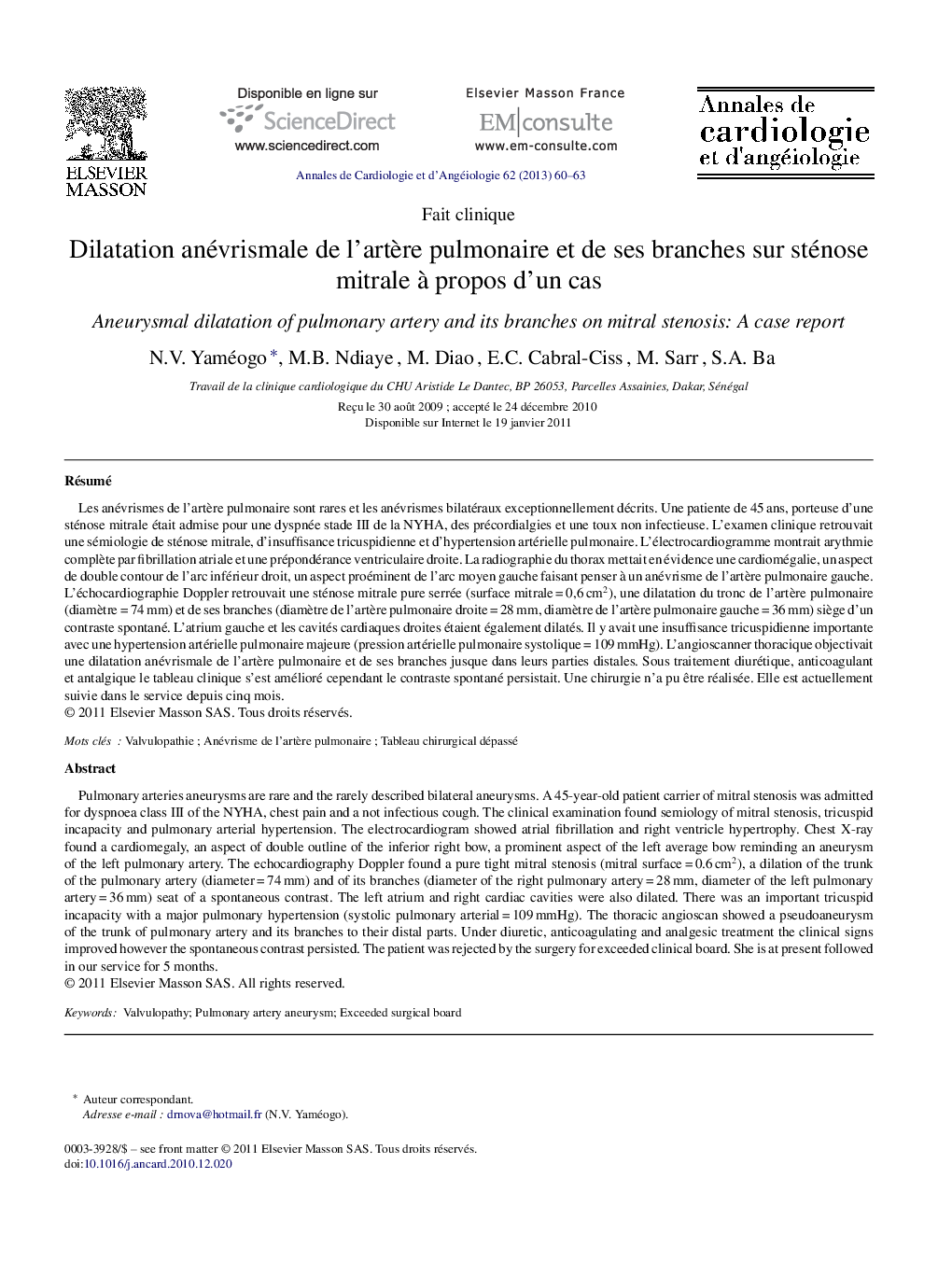| Article ID | Journal | Published Year | Pages | File Type |
|---|---|---|---|---|
| 2869014 | Annales de Cardiologie et d'Angéiologie | 2013 | 4 Pages |
RésuméLes anévrismes de l’artère pulmonaire sont rares et les anévrismes bilatéraux exceptionnellement décrits. Une patiente de 45 ans, porteuse d’une sténose mitrale était admise pour une dyspnée stade III de la NYHA, des précordialgies et une toux non infectieuse. L’examen clinique retrouvait une sémiologie de sténose mitrale, d’insuffisance tricuspidienne et d’hypertension artérielle pulmonaire. L’électrocardiogramme montrait arythmie complète par fibrillation atriale et une prépondérance ventriculaire droite. La radiographie du thorax mettait en évidence une cardiomégalie, un aspect de double contour de l’arc inférieur droit, un aspect proéminent de l’arc moyen gauche faisant penser à un anévrisme de l’artère pulmonaire gauche. L’échocardiographie Doppler retrouvait une sténose mitrale pure serrée (surface mitrale = 0,6 cm2), une dilatation du tronc de l’artère pulmonaire (diamètre = 74 mm) et de ses branches (diamètre de l’artère pulmonaire droite = 28 mm, diamètre de l’artère pulmonaire gauche = 36 mm) siège d’un contraste spontané. L’atrium gauche et les cavités cardiaques droites étaient également dilatés. Il y avait une insuffisance tricuspidienne importante avec une hypertension artérielle pulmonaire majeure (pression artérielle pulmonaire systolique = 109 mmHg). L’angioscanner thoracique objectivait une dilatation anévrismale de l’artère pulmonaire et de ses branches jusque dans leurs parties distales. Sous traitement diurétique, anticoagulant et antalgique le tableau clinique s’est amélioré cependant le contraste spontané persistait. Une chirurgie n’a pu être réalisée. Elle est actuellement suivie dans le service depuis cinq mois.
Pulmonary arteries aneurysms are rare and the rarely described bilateral aneurysms. A 45-year-old patient carrier of mitral stenosis was admitted for dyspnoea class III of the NYHA, chest pain and a not infectious cough. The clinical examination found semiology of mitral stenosis, tricuspid incapacity and pulmonary arterial hypertension. The electrocardiogram showed atrial fibrillation and right ventricle hypertrophy. Chest X-ray found a cardiomegaly, an aspect of double outline of the inferior right bow, a prominent aspect of the left average bow reminding an aneurysm of the left pulmonary artery. The echocardiography Doppler found a pure tight mitral stenosis (mitral surface = 0.6 cm2), a dilation of the trunk of the pulmonary artery (diameter = 74 mm) and of its branches (diameter of the right pulmonary artery = 28 mm, diameter of the left pulmonary artery = 36 mm) seat of a spontaneous contrast. The left atrium and right cardiac cavities were also dilated. There was an important tricuspid incapacity with a major pulmonary hypertension (systolic pulmonary arterial = 109 mmHg). The thoracic angioscan showed a pseudoaneurysm of the trunk of pulmonary artery and its branches to their distal parts. Under diuretic, anticoagulating and analgesic treatment the clinical signs improved however the spontaneous contrast persisted. The patient was rejected by the surgery for exceeded clinical board. She is at present followed in our service for 5 months.
